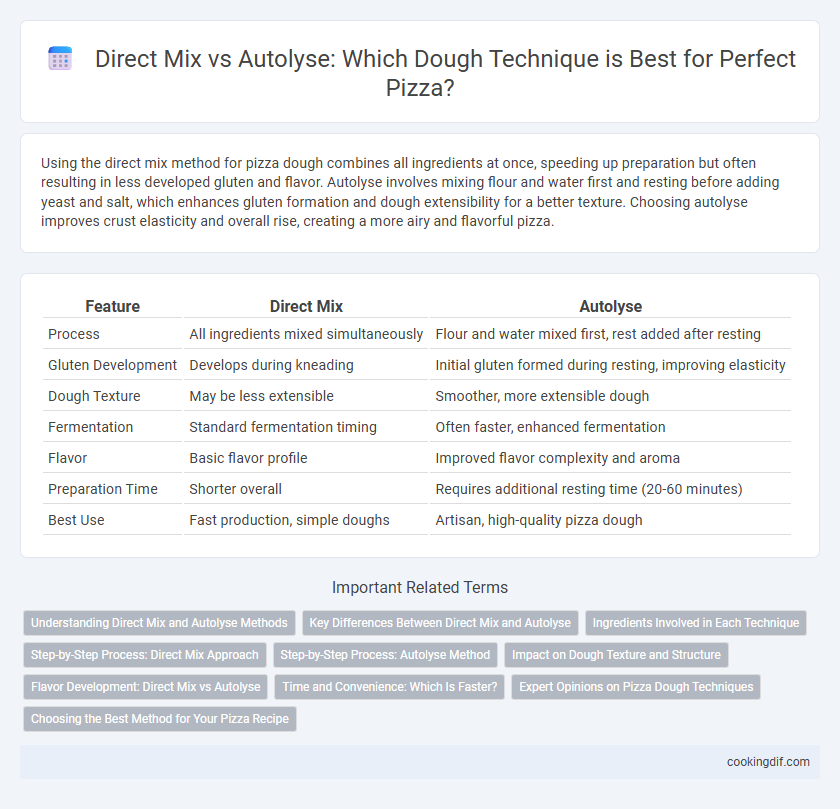Using the direct mix method for pizza dough combines all ingredients at once, speeding up preparation but often resulting in less developed gluten and flavor. Autolyse involves mixing flour and water first and resting before adding yeast and salt, which enhances gluten formation and dough extensibility for a better texture. Choosing autolyse improves crust elasticity and overall rise, creating a more airy and flavorful pizza.
Table of Comparison
| Feature | Direct Mix | Autolyse |
|---|---|---|
| Process | All ingredients mixed simultaneously | Flour and water mixed first, rest added after resting |
| Gluten Development | Develops during kneading | Initial gluten formed during resting, improving elasticity |
| Dough Texture | May be less extensible | Smoother, more extensible dough |
| Fermentation | Standard fermentation timing | Often faster, enhanced fermentation |
| Flavor | Basic flavor profile | Improved flavor complexity and aroma |
| Preparation Time | Shorter overall | Requires additional resting time (20-60 minutes) |
| Best Use | Fast production, simple doughs | Artisan, high-quality pizza dough |
Understanding Direct Mix and Autolyse Methods
Direct mix involves combining all ingredients simultaneously, enabling faster dough preparation but potentially sacrificing gluten development and flavor complexity. Autolyse method separates the initial hydration period, allowing flour to fully absorb water, enhancing gluten strength and dough extensibility for superior pizza crust texture. Bakers aiming for chewy, well-structured dough often prefer autolyse, while direct mix suits quick production scenarios.
Key Differences Between Direct Mix and Autolyse
Direct mix incorporates all ingredients simultaneously, resulting in a quicker dough preparation but potentially less gluten development. Autolyse involves mixing flour and water first, allowing enzymatic activity to improve dough extensibility and flavor before adding yeast and salt. This technique enhances fermentation, texture, and overall dough handling compared to the direct mix method.
Ingredients Involved in Each Technique
Direct mix dough technique involves combining all ingredients--flour, water, yeast, salt, and sometimes sugar and oil--simultaneously, promoting ease and speed in the mixing process. Autolyse technique separates the initial mixing by combining only flour and water, allowing enzymatic activity to improve gluten development before adding yeast, salt, and other ingredients. The autolyse method enhances dough extensibility and fermentation by optimizing hydration and flour enzyme interactions prior to full ingredient integration.
Step-by-Step Process: Direct Mix Approach
The Direct Mix approach to pizza dough involves combining all ingredients--flour, water, yeast, salt, and sometimes sugar--simultaneously before kneading. Mixing continues until the dough achieves a smooth and elastic texture, typically taking about 8 to 10 minutes with a stand mixer or 12 to 15 minutes by hand. This straightforward method accelerates dough preparation, making it ideal for quick pizza production while still developing adequate gluten structure.
Step-by-Step Process: Autolyse Method
The autolyse method involves mixing only flour and water initially, allowing this mixture to rest for 20-60 minutes to enhance gluten development and dough extensibility. After autolyse, yeast, salt, and other ingredients are incorporated, followed by kneading to create a well-structured dough with improved flavor and texture. This step-by-step process improves hydration and enzymatic activity, resulting in superior pizza dough compared to the direct mix method.
Impact on Dough Texture and Structure
Direct mix technique in pizza dough creates a denser texture with a tight crumb due to immediate gluten development, enhancing dough elasticity but resulting in less extensibility. Autolyse involves resting flour and water before adding yeast and salt, allowing enzymes to break down starches, which improves dough extensibility and promotes an open, airy crumb with a softer texture. The autolyse method also contributes to better gluten network formation, leading to improved dough strength and enhanced oven spring during baking.
Flavor Development: Direct Mix vs Autolyse
Direct mixing combines all ingredients at once, resulting in a faster dough preparation but less enzymatic activity for flavor complexity. Autolyse involves mixing flour and water first, allowing enzymes to break down starches and proteins, which enhances gluten development and intensifies the dough's natural flavors. This technique produces a more aromatic, deeper-tasting pizza crust due to improved fermentation and Maillard reactions during baking.
Time and Convenience: Which Is Faster?
Direct mix dough technique completes the process in about 10-15 minutes by combining all ingredients at once, offering maximum convenience for quick preparation. Autolyse requires a resting period of 20-60 minutes, allowing flour hydration and enzymatic activity to improve dough extensibility but extending total preparation time. For faster pizza dough preparation, direct mix is more efficient, while autolyse provides enhanced dough quality at the expense of additional time.
Expert Opinions on Pizza Dough Techniques
Expert pizzaiolos emphasize that the autolyse method enhances gluten development and dough extensibility by hydrating flour before mixing, resulting in a more elastic and flavorful crust. In contrast, direct mix, favored for its simplicity and speed, combines all ingredients at once but may require longer kneading to achieve similar gluten structure. Industry professionals often recommend autolyse for high-hydration doughs to optimize texture and oven spring in artisanal pizza preparation.
Choosing the Best Method for Your Pizza Recipe
Direct mix involves combining all ingredients at once, offering a straightforward approach suitable for quick pizza dough preparation. Autolyse, which entails mixing flour and water first and resting before adding yeast and salt, enhances gluten development and dough extensibility, resulting in a chewier crust and improved flavor. Selecting the best method depends on desired dough texture, flavor complexity, and preparation time for your specific pizza recipe.
Direct mix vs autolyse for dough technique Infographic

 cookingdif.com
cookingdif.com